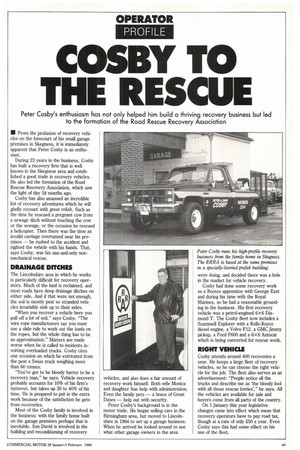COSBY TO THE RESCUE
Page 51

If you've noticed an error in this article please click here to report it so we can fix it.
• From the profusion of recovery vehicles on the forecourt of his small garage premises in Skegness, it is immediately apparent that Peter Cosby is an enthusiast.
During 23 years in the business, Cosby has built a recovery firm that is well known in the Skegness area and established a good trade in recovery vehicles. He also led the formation of the Road Rescue Recovery Association, which saw the light of day 18 months ago.
Cosby has also amassed an incredible list of recovery adventures which he will gladly recount with great relish. Such as the time he rescued a pregnant cow from a sewage ditch without touching the cow or the sewage, or the occasion he rescued a helicopter. Then there was the time an invalid carriage overturned near his premises — he rushed to the accident and righted the vehicle with his hands. That, says Cosby, was his one-and-only nonmechanical rescue.
The Lincolnshire area in which he works is particularly difficult for recovery operators. Much of the land is reclaimed, and most roads have deep drainage ditches on either side. And if that were not enough, the soil is mostly peat so stranded vehicles invariably sink up to their axles.
"When you recover a vehicle here you pull off a lot of soil," says Cosby. "The wire rope manufacturers say you must use a slide rule to work out the loads on the ropes, but the whole thing has to be an approximation." Matters are made worse when he is called to incidents involving overloaded trucks. Cosby cites one occasion on which he extricated from the peat a Swiss truck weighing more than 60 tonnes.
"You've got to be bloody barmy to be a recovery man," he says. Vehicle recovery probably accounts for 10% of his firm's turnover, but takes up 30 to 40% of his time. He is prepared to put in the extra work because of the satisfaction he gets from recoveries.
Most of the Cosby family is involved in the business: with the family home built on the garage premises perhaps that is inevitable. Son David is involved in the building and reconditioning of recovery vehicles, and also does a fair amount of recovery work himself. Both wife Monica and daughter Sue help with administration. Even the family pets — a brace of Great Danes — help out with security.
Peter Cosby's background is in the motor trade. He began selling cars in the Birmingham area, but moved to Lincolnshire in 1964 to set up a garage business. When he arrived he looked around to see what other garage owners in the area were doing, and decided there was a hole in the market for vehicle recovery.
Cosby had done some recovery work as a Rootes apprentice with George East and during his time with the Royal Marines, so he had a reasonable grounding in the business. His first recovery vehicle was a petrol-engined 6x6 Diamond T. The Cosby fleet now includes a Scammell Explorer with a Rolls-Royce diesel engine, a Volvo F12, a GMC Jimmy pickup, a Ford F600 and a 6x6 Autocar which is being converted for rescue work.
Cosby attends around 400 recoveries a year. He keeps a large fleet of recovery vehicles, so he can choose the right vehicle for the job. The fleet also serves as an advertisement "People notice all the trucks and describe me as 'the bloody fool with all those rescue lorries'," he says. All the vehicles are available for sale and buyers come from all parts of the country.
On 1 January this year legislative changes came into effect which mean that recovery operators have to pay road tax, though at a rate of only 250 a year. Even Cosby says this had some effect on his use of the fleet.
























































































